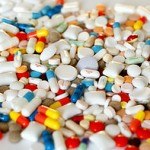 The use of pharmaceutical drugs is on the rise in America. According to the Mayo Clinic, the amount of Americans who take at least one prescription drug rose from 48 percent to 70 percent between 2007 and 2013 alone. One unexpected side effect of this increased usage of pharmaceutical drugs is that they are turning up in our nation’s water supplies. Today we’re going to talk about how pharmaceutical drugs get into drinking water and what you can do to remove them from the water in your home!
The use of pharmaceutical drugs is on the rise in America. According to the Mayo Clinic, the amount of Americans who take at least one prescription drug rose from 48 percent to 70 percent between 2007 and 2013 alone. One unexpected side effect of this increased usage of pharmaceutical drugs is that they are turning up in our nation’s water supplies. Today we’re going to talk about how pharmaceutical drugs get into drinking water and what you can do to remove them from the water in your home!
How do pharmaceutical drugs get into drinking water?
Pharmaceutical drugs get into drinking water in one of two ways. One way is through urine. When people consume pharmaceutical drugs, small traces of the drugs remain in their urine. Those small traces then end up in our wastewater and eventually into the water supplies that we use for our drinking water.
The second way that pharmaceutical drugs get into drinking water is by people flushing expired and unused drugs down the toilet.
How prevalent are pharmaceutical drugs in drinking water?
A study was recently conducted on 50 large-sized water treatment plants around the country. The researchers tested for 56 different drugs, including oxycodone, high blood pressure medications and over-the-counter drugs. The study found that more than half of the samples tested positive for 25 of the drugs, with high blood pressure medications being found most frequently and at the highest concentrations.
Even though pharmaceutical drugs are commonly found in our water supplies, there are currently no state or federal regulations requiring drinking water plants to monitor for them.
What are the health effects of pharmaceutical drugs in drinking water?
At this point, the health effects of pharmaceutical drugs on humans is unclear, and little testing has been done. However, testing on fish in water supplies that contain traces of pharmaceutical drugs has revealed that the drugs negatively affect the hormones of the fish. Many of the fish that were tested developed both male and female characteristics.
In addition, we know that hormones work at very low concentrations in the human body, so even the small traces of the drugs in our water supplies could potentially have negative consequences.
How can you remove pharmaceutical drugs from your drinking water?
Because water treatment plants do not test for pharmaceutical drugs, the best way to remove them from your drinking water is to install a residential water treatment system. EPA Water offers a number of different products that will remove traces of pharmaceutical drugs from your drinking water so that you can be sure that the water you are drinking is pure and healthy.
If you have any questions about pharmaceutical drugs in drinking water, or if you’d like a water treatment system serviced or installed in your home, contact EPA Water Consultants, your Eastern Pennsylvania and New Jersey dealer of water filtration and water softening systems. We service areas all over Pennsylvania and New Jersey, including towns like Linfield, Lower Gwynned and Lower Makefield, PA.
photo credit: Gatis Gribusts via photopin cc
